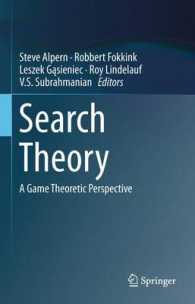Full Description
Police & Society, Seventh Edition, offers an in-depth and analytical look at policing, from police behavior and organization to operations and historical perspectives. Focusing on the relationship between the police and the community and how it has changed throughout the years, the authors explore the most important theoretical foundations and incisive research on contemporary policing and show how that research is put into practice. The text isenhanced by extensive pedagogy and a unique chapter on higher education and policing.
Contents
PrefaceAcknowledgments: About the Authors: PART I: POLICING FOUNDATIONSCHAPTER 1. Police in a DemocracyPolicing a Free SocietyPolice and GovernmentPolice and Rule of LawPolice, Terrorism, and Homeland SecurityPolice SystemsThe U.S. Police SystemOther Types of Law Enforcement AgenciesSimilarities and DifferencesPolice Role and PurposeLaw Enforcement or Politics?Crime Fighting or Social Service?Proactive or Reactive?Police Activities and WorkloadPolice Goals and StrategiesLooking AheadSummaryCHAPTER 2. Police HistoryFoundations of PolicingEarly PolicingPolicing in Nineteenth-Century EnglandThe Emergence of Modern Policing in the United StatesThe First City Police ForcesThe County SheriffVigilance CommitteesModern American PolicingThe Political EraPolice DevelopmentCriticism in the Political EraThe Reform EraSouthern Colonial and Frontier Police Development: A Minority Perspective on the Development of American PoliceState PoliceTexas and MassachusettsPennsylvaniaHighway PatrolFederal Law EnforcementThe Revenue Cutter Service and the U.S. Marshal ServicePostal InspectorsThe Secret ServiceThe Federal Bureau of InvestigationSummaryCHAPTER 3. Legal IssuesCriminal ProcedureSearches and Seizures of PersonsSearches and Seizures of PropertyInterrogations and ConfessionsCivil LiabilityCosts of Liability in PolicingAvenues of LiabilityCivil Liability in State CourtsCivil Liability in Federal CourtsEmerging Liability Issues for the Twenty-First CenturyUse of ForceImpact on OfficersSummaryCHAPTER 4. Police StrategiesEvolving Strategies of PolicingLandmark Studies of Police EffectivenessPatrol StudiesResponse Time StudiesCriminal Investigation StudiesStrategic DevelopmentsImproving Crime-Control EffectivenessImproving Police-Community RelationsImproving ProfessionalismDeveloping Evidence-Based PracticesStrategic AlternativesCommunity PolicingProblem-Oriented PolicingIntelligence-Led PolicingPredictive PolicingWhat Works in PolicingSummaryPART II: POLICE ADMINISTRATIONCHAPTER 5. Police ManagementThe Managerial ProcessThe Development of Police ManagementClassical Police ManagementBehavioral Police ManagementContemporary Police ManagementOrganizational DesignCriticisms of the Paramilitary DesignInfluence of Community PolicingStructuring Police DiscretionManaging Police PerformanceMeasuring What MattersPolice Organizational PerformancePolice Unit PerformanceSupervision & Police PerformanceManaging Group BehaviorPolice SubculturesEmployee OrganizationsPolice UnionsManaging Critical IncidentsMedia Relations & Strategic CommunicationsSummaryCHAPTER 6. Organizational ChangeOrganizational ChangeReorganizingImproving Leadership and ManagementRevising Policies and ProceduresChanging Strategies and TacticsChanging BehaviorChanging Organizational CultureThe Change ProcessResistance to ChangeOvercoming Resistance to ChangeThe Madison ExperienceLaying the FoundationKey Elements to ChangeResults from MadisonExperiences in Other DepartmentsChicagoNew YorkLos AngelesCincinnatiPittsburghInstitutionalizing Innovation & ChangeMeasuring What MattersContinuous ImprovementResearch and DevelopmentEducation and TrainingSummaryCHAPTER 7. Selection and DevelopmentRecruitmentRecruitment MethodsTargeting Females and MinoritiesRecruitment ToolkitTargeting the Service OrientedSelectionPreemployment StandardsGeneral SuitabilityPreemployment TestingRecruit Screening MethodsAmericans with Disabilities ActDevelopmentRecruit TrainingProgram OrientationPhilosophy and Instructional MethodsCurriculum Development and ContentCurriculum UpdatesEffectiveness of Recruit TrainingField TrainingField Training Officer ProgramPolice Training Officer ProgramCareer GrowthSummaryCHAPTER 8. Field OperationsThe Patrol FunctionHistorical DevelopmentPatrol MethodsUse of Patrol ResourcesFocused InterventionsProactive Arrests and CrackdownsGuns and Gang ViolenceFocused Deterrence InitiativesPolicing Disorder: Zero-Tolerance and Quality-of-Life PolicingPolice PursuitsThe Investigative FunctionHistorical DevelopmentSelected Research on Investigative OperationsAdvances in Physical EvidenceThe Automated Fingerprint: Identification System and DNA: Bias Crime ProgramsDetective-Patrol RelationshipsSummaryPART III: POLICE BEHAVIORCHAPTER 9. Behavior and MisconductPerspectives of Police BehaviorUniversalistic PerspectivesParticularistic PerspectivesSocialization Versus PredispositionEarly Examinations of Police BehaviorDecision Making and Police DiscretionOrganizational VariablesNeighborhood VariablesSituational VariablesIndividual (Officer) VariablesPolice DevianceTypes of Deviance and MisconductThe Prevalence of Police DevianceDeviant OfficersThe Persistence of CorruptionAre Gratuities a Type of Misconduct?Police Sexual MisconductThe Drug War and Police DevianceOrganizational ResponsesSummaryCHAPTER 10. Force and CoercionPolice-Citizen InteractionsContext of ForceNational Estimates on Police Use of ForceLearning to Use ForceTrainingReengineering TrainingAreas of TrainingPolice Culture and the Use of ForceControversy and the Use of ForceInappropriate ForceBrutality and Excessive ForcePhysical and Psychological Force in Police HistoryFrequency of Excessive Force and BrutalityBrutality in the Twenty-First CenturyDeadly ForceCategory 1: DeathCategory 2: InjuryCategory 3: NoninjuryIndividual and Situational FactorsEnvironmental and Departmental VariationsRacial ConsiderationsLegal and Policy ChangesSummaryCHAPTER 11. Accountability and EthicsInternal Accountability MechanismsBureaucratic Organization and ManagementInternal InvestigationIssues in Internal InvestigationsEarly Warning/Early Identification SystemsBody-Worn Cameras (BWC)Effectiveness of Internal InvestigationsExternal Accountability MechanismsCivilian ReviewPolice Auditor SystemsThe Limits of Oversight MechanismsProfessional StandardsThe Police Professionalization MovementCriteria of Police ProfessionalizationEthical StandardsEthical PerspectivesEthical DilemmasThe Limits of Professional and Ethical StandardsSummaryPART IV: CONTEMPORARY ISSUESCHAPTER 12. DiversityRacial Minorities in PolicingUnequal TreatmentPerformance of African American PoliceWomen in PolicingUnequal TreatmentPerformance of Women OfficersAffirmative ActionEqual Employment OpportunityIncreasing Diversity in Police DepartmentsPromotional OpportunitiesIntegration of Minorities and Women Into PolicingPolice CultureStructural CharacteristicsPregnancy and MaternitySexual HarassmentLesbian, Gay, Bisexual, and Transgender OfficersFuture ProspectsSummaryCHAPTER 13. Stress and Officer SafetyThe Concept of StressOccupational StressOverview of StressorsPolice StressorsEmerging Sources of StressLine-of-Duty and Crisis SituationsPosttraumatic Stress DisorderShift WorkSocial Supports and Police StressConsequences of StressAlcohol AbuseDrug AbuseSuicideStress and the Impact on FamiliesPolicies and ProgramsOfficer SafetyDanger and Police WorkImproving Safety and Reducing FatalitiesSummaryCHAPTER 14. Higher EducationThe Development of Higher-Education Programs for PoliceFederal Programs and Support for Higher EducationQuality of Higher-Education ProgramsHigher-Education Requirements for PoliceThe Impact of Higher Education on PolicingHigher Education and AttitudesHigher Education and PerformanceHigher Education and Use of ForceHigher Education and PromotionHigher Education and Job SatisfactionHigher Education and TerrorismValidating Higher Education for PoliceHigher Education as a Bona Fide Occupational QualificationHigher Education and DiscriminationHigher-Education Incentive ProgramsHigher-Education Requirements and Policy ImplicationsMoving Forward: Beyond Traditional University-Based Education?SummaryCHAPTER 15. Emerging IssuesChanges in American SocietyGenerational DifferencesCultural DiversityImmigration and MigrationShifting EconomicsModern ProblemsCrime TrendsMental HealthDrugsPolice LegitimacyModern TechnologyCrime Detection and Crime SolvingSurveillance and PrivacyOfficer Safety and AccountabilitySocial MediaLong-Term TrendsProfessionalizationPrivatizationFederalizationMilitarizationTerrorism and Homeland SecuritySummaryVoices from the Field: Biographical SketchesGlossary: Name Index: Subject Index:








